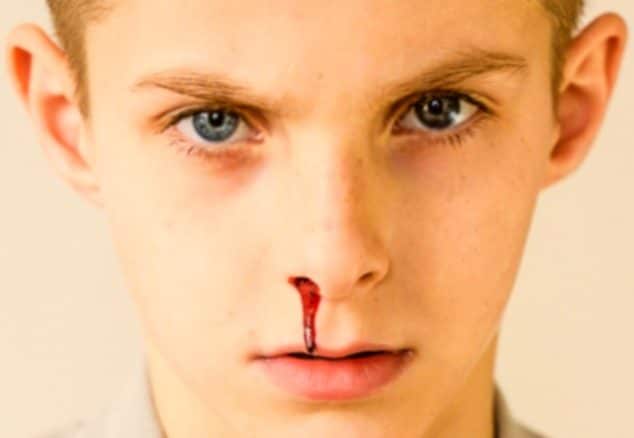
Contents [show]
How to stop nose bleeding in young children?
Young children frequently bleed from the nose. To be able to do this effectively, you need to be aware of the causes, know how to stop nose bleeding, and learn some prevention strategies. Read the following article to learn more.
causes of nose bleeding
Be aware that the young child’s behavior makes bleeding more likely
The nose is filled with small blood vessels that are easily irritated when banged or pierced. Since young children are so curious, careless and clumsy, they are much more likely to have a bleeding nose. They could put their fingers or small objects in their noses, they could slip and fall often, and these activities tend to cause bleeding to the nose [1].
Be aware that repeated colds can cause nosebleeds
If your young child is taking an antihistamine nasal spray, it is much more likely to bleed. These medications dry up the nasal cavities, making them more prone to irritation and bleeding [2].
Think about the weather
Cold, dry weather causes nosebleeds. This problem is often exacerbated by indoor heating systems that tend to dry out the lining of the nose, making it more sensitive and more prone to bleeding [3].
Ask your pediatrician if your child will not have a blood clotting problem
In rare cases, nosebleeds in young children may be a sign of a medical condition that prevents the blood from clotting properly. Your pediatrician can give you tests to check for this condition [4].
In most cases, young children with blood clotting problems are born in families where such cases already exist. If you, your partner or other close family member have a blood clotting problem, you should talk to your pediatrician right away.
How to Stop the nose bleeding?
Stay calm
In the vast majority of cases, nosebleeds should not be a problem. If you panic for no reason, you will scare your child and make the situation worse. Stay as calm as possible.
You have even more reason to stay calm if you know that the bleeding is the result of the curiosity of your child who has “explored” his nose too much. This is not the time to punish or scold him or annoy you. Stay calm and take care of the bleeding before taking care of his cause.
Assess the situation
If the bleeding in your young child’s nose has been caused by a fall or other injury, especially if your child has fallen head first or if he has been hit in the face, you must make sure there is no has no more serious injuries.
If your child has fallen and if he has hit his face, and you see that swelling is accompanying the bleeding, you must get medical treatment quickly. The nose could be broken.
Go to the best place available to deal with the bleeding nose
If possible, take your child to the bathroom (or in a room where there is no carpet, because the blood can leave traces). If you are in a public place, it is better that you take your child away from the sight of passersby, some people feel sick or may faint at the sight of blood.
Position your child properly
Your young child’s head should be in a higher position than his or her heart to avoid adding more pressure to the nose, which could increase bleeding. For best results, ask your child to sit on a chair or your lap.
If you lengthen your child, blood may flow down your throat, which may cause nausea and vomiting. The best thing to do is to sit down.
Ask your child to spit out any blood in his mouth
Using a basin, paper tissue or sink, help your child gently spit the blood in his mouth.
Help your child lean forward
Whether you have your young child sitting on a chair or in your lap, you have to lean forward a little.
If your child is sitting on a chair, put a hand on his or her back and gently press it to lean it forward.
If your child is sitting on your lap, gently lean forward pushing.
Wipe the blood that you can see
Using a tissue, towel, or other soft cloth, wipe off visible traces of blood.
Encourage your toddler to blow his nose gently
If your child already knows how to blow his nose on his own, it will help him eliminate excess blood.
Pinch your child’s nose to close it
Use your fingers to keep your child’s nose closed. Go slowly, if you pinch too hard, it may well be that your child is struggling, he could then hurt himself, which would worsen the situation.
Make sure you never cover your child’s mouth. He must be able to breathe freely.
Check the bleeding condition from time to time
After pinching your nose for 5 minutes, check to see if the bleeding stopped. If the nose is still bleeding, continue to pinch for another five to ten minutes.
Try to use a cold compress to stop nose bleeding
If the bleeding does not stop, place a cold compress on the edge of your child’s nose. The compress helps tighten blood vessels and may help stop bleeding.
Let your child rest
Once the bleeding has stopped, try to let your child rest. Ask him not to touch his nose and not blow his nose.
Decide if you need to see a doctor
Seek a doctor immediately if your child is injured. Also, you must contact your pediatrician if any of the following situations occur:
- your child has a bleeding nose several times a week.
- if your child is taking a new medicine recently.
- your child has severe headaches.
- if your child has to bleed elsewhere, such as ears, mouth or gums, or blood in his / her stool
- your child has unexplained blues on the body
Clean
Once you have cared for your child, clean the blood that has spilled on the furniture, floor, and worktop. Clean with disinfectant.
Prevent bleeding in the future
Make sure your child’s nose is moist
If your child often bleeds from the nose, apply a product such as petroleum jelly to keep the inside of his nose moist. You can also moisten the inside of your nose with a saline spray.
You should also install a humidifier in his room. Humidifiers prevent the air from becoming too dry, which can help prevent frequent bleeding from the nose.
Avoid allergens
You could prevent your child from bleeding from the dust and other allergens in his / her room as they can dry out the lining and cause bleeding in the nose. Pay particular attention to carpets, curtains, and stuffed animals as they can trap and trap allergens.
Cut the nails of your young child
Young children are curious creatures who tend to put their fingers in the nose. If you trim your child’s fingernails, he will be much less likely to be bleeding from his nose.
Pay attention to his diet
To strengthen your child’s immune system and make sure your blood vessels are healthy, you should avoid giving it artificial sweeteners and you must increase the amount of omega 3 fatty acids you give it. Salmon and flaxseed oil are excellent sources of omega 3.
Tips
- Never put tissues or anything else in your young child’s nose to stop bleeding. When you take it out, you could damage the clot and restart the bleeding.
- If you are afraid of putting blood on your hands, you can wear a pair of latex gloves while you are caring for your child. You will find it in most stores, in the department with dressings and first aid products.
- Blood can stain clothes, especially if they are not completely rinsed before drying. Rinse all the clothes your child wore during bleeding as soon as possible and avoid using cloth instead of paper tissues.




